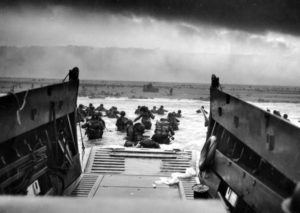If you don’t look too closely, Normandy’s beaches, from Vierville-sur-Mer and five miles to the east, look like any other holiday spot in the northwest of France.
Long, sandy stretches that can be hundreds of yards deep, when the tide is out. A sea wall, in many places.
And steep bluffs rising behind the beach.
For the French, especially from Paris, this is where to go to get a tan.
For Americans, this is where to go to get a lesson in history and sacrifice.
It was at this long beach — code-named Omaha Beach — where the U.S. First and 29th divisions struggled ashore on the morning of D-Day, June 6, 1944, above, to begin the Allies’ final, bloody assault on Hitler’s failing Reich.
For Americans, it seems almost like sacred ground, even 72 years later.
Any U.S. citizen who travels to Paris has the opportunity to visit the landing site under a five-hour guided tour and return to the French capital in the same day.
Locations typically visited in tours during the summer season include:
—Pointe du Hoc, where two battalions of the newly created Army Rangers struggled up the side of a sheer cliff to destroy an artillery park — from where the guns had recently been removed a few miles inland.
–The beach below Vierville-sur-Mer, where the 116th regiment of the untested 29th Division suffered heavy casualties from strong German positions in the bluffs of what the invaders called the “Vierville Draw”.
–The Normandy American Cemetery and Memorial, just above the point where the Big Red One, as the First Division is known, landed on D-Day. More than 9,300 Americans killed near the beaches are buried in the perfectly straight rows there, and a long wall lists the names of the 1,500 Americans whose bodies were never identified.
It is good to have a guided tour, and perhaps even better if the tour is run by the French, because they have a slightly different perspective on the invasion of Normandy. For them, it was an enormous battle that broke out in their backyard, killing about 10 percent of the local population.
Mathieu was the twentysomething guide of our group of eight, which he picked up at the Bayeux train station and drove to the various sites. He has a heavy accent but everyone seemed to understand him. He rarely stops talking … because he has so much to say.
He seems keen to make a few points of particular personal interest.
As a student of military history, he becomes agitated at incorrect portrayals of what went on, on June 6 and he believes two famous movies that spend a lot of time on Omaha Beach — The Longest Day and Saving Private Ryan — get several things wrong, some big and some little.
–The Germans had no bunkers atop the bluff where the 116th regiment of the 29th Division came ashore, he says, because a bunker would have been too easy to attack by plane or naval gunnery. Instead, he said (and pointed out examples), the German positions were hidden in the bluff and sent fire at angles across the beach. Crossfire killed the Americans on the beach, not direct fire from above.
–The Longest Day is far too sanitized, he believes, in depicting extreme violence, and too many old actors played too many young men — John Wayne, for instance, as Lt. Colonel Benjamin Vandervoort. The former was 55 years old when the film was released. Vandervoort was 27 on June 6, 1944. Mathieu said the average age of a soldier in the invasion force was 19.
–Mathieu insists the underwater mines at Omaha Beach meant to destroy landing ships are pointed in the wrong direction — toward the shore, instead of toward open water, in Saving Private Ryan.
Mathieu also took us to a cemetery in the area for the German dead, and the simple and severe and largely overlooked place contains twice as many dead as does the well-manicured and heavily visited American cemetery with its marble crosses and stars, nearby.
The visit is well worth the time and expense. We paid 28 euros (about $30) for a roundtrip train ride from the Saint-Lazare station, in Paris, and 60 euros for the five-hour tour.
One small part of the tour that may stick with me for a while is a bronze statue on Omaha Beach of two soldiers of the 29th Division. One has been struck by enemy fire, but still has a grip on his rifle, and the other is dragging him toward cover.
Have a look. It is even more powerful in person and gives us a bit of a sense of the events of that day.


1 response so far ↓
1 michael ferguson // Oct 13, 2016 at 8:52 AM
Hi Paul, I toured Normandy in 2006 with a personal guide named Mathieu and I cannot remember his last name or find his contact info. He was a young man with glasses and had grandparents that lived in the Normandy area. I have a good friend that is going to visit next month and I recommended Mathieu and said i would try to find his info. I think you may have used the same Mathieu based on your comments: his age as he was maybe 23-24, his passion for the facts and he also took me to the German cemetery which I had never really heard mentioned in all of my reading about Normandy, Do you by chance still have his email or contact info you could pass along to me. I knew a lot about the whole battle, or i thought is did, but he took me to places i never would have found on my own that made it a great day with him. Thanks.
Leave a Comment